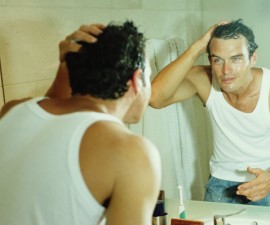Many black men suffering from receding hairline. In many cases, the problem is likely to be associated with genetic trait and oversensitive to an androgen called DHT – though this also could be due to their hairstyles (especially such as tight curled hairstyles, like cornrows) that put more stress on the hairline, causing hair follicle damage. How to stop it? There are some treatments to choose from!
The main treatments
Many times, receding hairline is early sign of hair loss problem called androgenetic alopecia (much familiar called pattern baldness). In men, it is often called as male pattern baldness.
To cope with male pattern baldness, there are two approved conventional treatments; minoxidil and finasteride. Most of minoxidil products can be purchased without prescription, while finasteride is usually available by prescription.
Minoxidil
Minoxidil for hair loss treatment is used topically. Currently, there are two options; foam and topical solution. What you need to do is applying it directly to your scalp twice a day– or you can follow the directions on the package!
For most black men, it is safe. However, there are also some possible side effects such as the risk of having more dandruff and scalp irritation (rare).
Again, minoxidil such as Rogaine has been approved for treating male pattern baldness. But it is less likely to work for receding hairline. It’s likely recommended for other signs of pattern baldness (such as thinning hair on the crown, or thinning hair all over the scalp (typically found in female pattern baldness)).
It doesn’t target the main underlying cause of male pattern baldness in most cases, the excess DHT in the scalp. See more facts about minoxidil in this section!
Finasteride (propecia)
Minoxidil is the first treatment approved by FDA for pattern baldness, then followed by finasteride. However, finasteride is the first treatment that works effectively in treating many cases of pattern baldness.
In general, finasteride is more recommended for the first treatment choice in coping with receding hairline. Unlike minoxidil, it can help reduce the production of DHT.
DHT stands for dihydrotestosterone. It is actually a male sex hormone, an androgen.
And it’s thought that hair follicles of men with male pattern baldness are genetically more sensitive to DHT. Interestingly, female pattern baldness is not associated with DHT.
Finasteride is not approved for women, including for those with female pattern baldness. Learn more about finasteride (propecia) in here!
Hair transplant
However, both medications (minoxidil and finasteride ) cannot provide permanent result. Many times, hair loss returns if you stop taking the treatment. Therefore, you need continuous use of this treatment – making it as a part of your daily routine, like shampooing your hair or brushing your teeth!





Propecia is the best choice to cope with early receding hairline, including for black men!